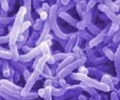
In the June issue of Remote Sensing Letters, Antarpreet Jutla, then a doctoral student at Tufts School of Engineering and now on the faculty at West Virginia University, was lead author on a study that measured chlorophyll and other organic matter.
The team, which was led by Shafiqul Islam, Ph.D., professor of civil and environmental engineering at Tufts School of Engineering, used satellite data to measure chlorophyll and algae, organic substances, and flora that also support growth of the cholera bacteria.
Using satellite images, the researchers created a "satellite water marker" (SWM) index to estimate the presence of organic matter including chlorophyll and plankton based on wavelength measurements.
A predominance of green, plankton-rich water— which is measured at 555 nanometers—indicated the degree to which the waters contained chlorophyll, plankton, and other impurities. Clear, blue water—measured at 412 nanometers—indicated low levels of these impurities, according to the researchers.
The researchers targeted the spring epidemic, which is a coastal phenomenon caused by water flow into the delta from three principal rivers – the Brahmaputra, Ganges, and Meghna. Unlike the spring outbreak, the fall epidemic is linked to flooding which follows the monsoons and subsequent breakdown of sanitary conditions rather than costal conditions.
Advertisement
They discovered a relationship between SWM index measurements taken in early winter—from October to December—and the severity of cholera epidemics in the following spring. "In short, the index for chlorophyll along with readings for other biological matter in early winter indicated severity of cholera incidences in the spring," says Jutla.
Advertisement
"The probability for error in this index-based estimate is less than 10 percent while the error in using the chlorophyll-based algorithm is about 30 percent," says Islam. To validate their hypothesis that the index can be used in coastal areas outside of the Bengal Delta, the team applied the SWM to coastal waters around Mozambique's capital city, Maputo.
Additional authors on this paper are Abu Syed Golam Faruque, and Rita Colwell of the Center for Bioinformatics and Computational Biology at the University of Maryland, and Anwar Huq of the Maryland Pathogenic Research Institute at the University of Maryland. Another member of the team, Ali Shafqat Akanda, was with the Center for Bioinformatics and Computational Biology at UM and is now on the faculty at the University of Rhode Island. He was a doctoral student at Tufts during the research.
In a separate paper that was published online in the journal Environmental Modeling and Software, ahead of the September 1 print edition, Jutla, Islam, and Akanda showed that air temperature in the Himalayan foothills can also be a factor in predicting spring cholera. The researchers collected air temperature data during the early winter months (October-December) in the foothills. In seasons of warm temperature, the foothills experienced higher than normal precipitation and early snow melt. This caused higher than normal water flow in the Ganges, Brahmaputra and Meghna Rivers and eventually into the Bay of Bengal during the drought period. Higher river flow into the delta impedes plankton-carrying seawater from moving inland
When correlated with satellite data on chlorophyll levels, the researchers found that air temperatures could lessen the extent of cholera even when chlorophyll levels were high.
Source-Eurekalert










